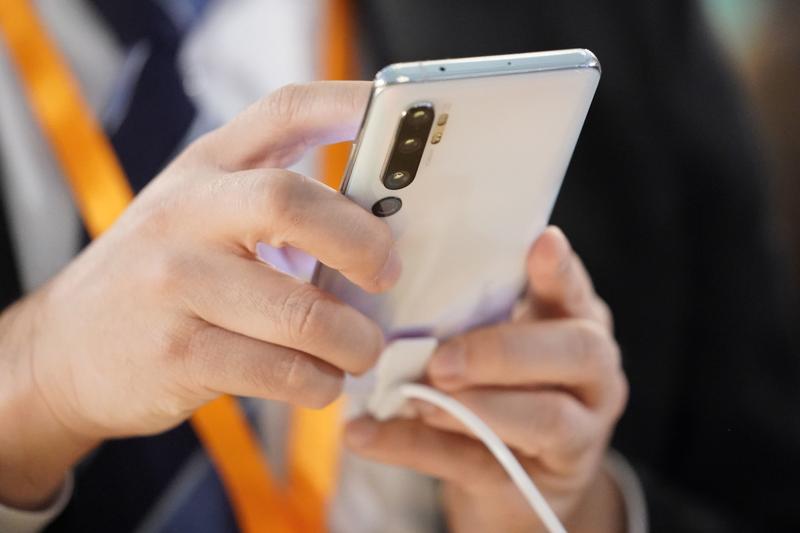 In this Dec 9, 2019 photo, an attendee uses a Xiaomi Corp Mi Note 10 smartphone during a news conference in Tokyo, Japan. (TORU HANAI / BLOOMBERG)
In this Dec 9, 2019 photo, an attendee uses a Xiaomi Corp Mi Note 10 smartphone during a news conference in Tokyo, Japan. (TORU HANAI / BLOOMBERG)
Xiaomi Corp’s shares leapt 11.4 percent after inroads into the Chinese mainland market for high-end smartphones and strong growth overseas helped the company report better-than-expected profit.
Xiaomi may be able to offset some of the hit through higher-margin phones and market share gains against biggest competitor Huawei Technologies Co
The stock climbed its most in two years in Hong Kong, taking its 2020 gains to 98 percent. The smartphone maker from the Chinese mainland more than doubled net income to 4.49 billion yuan (US$716 million) in the June quarter, beating the highest analyst estimate. Sales increased 3.1 percent to 53.5 billion yuan. Xiaomi’s overseas business has recovered to pre-COVID-19 levels, acting Chief Financial Officer Wang Xiang said Wednesday.
ALSO READ: Alibaba and Xiaomi get into Hong Kong's benchmark index
“Driven by a favorable competitive landscape, aggressive building of sales channels, increased R&D with strong product competitiveness, and continued adoption of 5G in the Chinese mainland and overseas market (Europe) in 2021, we expect strong value share gains starting 2H20,” Bocom International analysts including Chris Yim wrote in a report. Bocom, Morgan Stanley, CICC and Citigroup were among brokerages that lifted their price targets for Xiaomi’s stock.
Smartphone shipments in European countries like France and Spain grew by 64.9 percent in the quarter, propelling Xiaomi into the No 3 spot in the region for the first time, the company said, citing consultancy Canalys. The phonemaker also kept its top position in India in the quarter even though the country’s smartphone shipments halved during lockdown measures. That drove a 12 percent fall in the company’s device shipments globally, according to IDC, just when tensions between Delhi and Beijing threatened to further depress sales in its biggest foreign market.
Xiaomi may be able to offset some of the hit through higher-margin phones and market share gains against biggest competitor Huawei Technologies Co, which is struggling to sustain smartphone output because of US curbs on its in-house chip design and supply. Xiaomi shipped 28.3 million smartphones during the quarter, with average selling prices increasing 11.8 percent from a year earlier, reflecting deeper inroads into premium devices.
“Xiaomi could gain market share from Huawei in the Chinese mainland, Europe and LatAM market,” Citigroup analyst Andre Lin wrote in a report. “We believe this will accelerate smartphone growth on top of the 5G trend.”
The phone maker appointed a new chief financial officer, former Credit Suisse head of Asia technology Alain Lam, confirming a Bloomberg News report. The veteran investment banker, who worked on the public listings of Alibaba Group Holding Ltd, Google and Pinduoduo Inc, will take up his new role in October and could help Xiaomi uncover value in the more than 300 companies it has backed. That sprawling portfolio of startups, ranging from Segway owner Ninebot Inc to portable charger maker Zimi and Huami Corp, are key to Xiaomi’s longer-term ambition of building a network of home devices for the so-called Internet of Things.
READ MORE: Xiaomi vows to stick to 'strategic transformation'
In the Chinese mainland, domestically oriented businesses such as media and finance could bounce back alongside an economic recovery. Xiaomi, known for lower-priced phones, has been trying to lift its average retail price to cushion margins. Chief Executive Officer Lei Jun this month introduced a suite of smartphones priced close to the iPhone 11 and transparent TVs costing 49,999 yuan to commemorate the company’s 10th anniversary. The co-founder also pledged to develop advanced manufacturing to fuel Chinese mainland’s high-end electronics making ambition.
Xiaomi will join Hong Kong’s benchmark index from September in one of the gauge’s biggest revamps, a potential boost for the stock.


